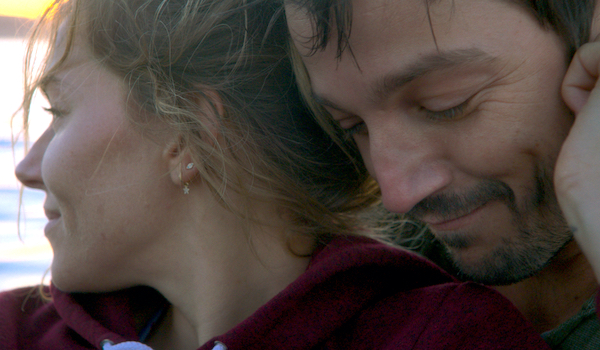“Just watching these flickering images up there, it was 16mm film rough cuts where you could see the splice tape and everything,” began Tara Miele, “It was the first time I understood, somebody made that.”
A self-described theater brat, Miele realized there was a storyteller behind her favorite films when a friend invited her to come and watch a series of student films. “I grew up a blue-collar kid in Long Island and never assumed that filmmaking was a job you could do.”
At the event, however, she said, “It was like somebody pulled back the curtain on Oz. I just knew I was going to be a filmmaker.” The following week, she marched into the Film Studies office and announced she wanted to make a movie.
Her first student film premiered at Slam Dance in 2000. “Taking a film [Wander Darkly] to Sundance [Film Festival] this year after twenty years on the journey was a really special thing for me.” It was also nominated for the Grand Jury Prize.

Tara Miele. Photo by Michael Moriatis
Creating Wander Darkly
In Miele’s latest film, Sienna Miller (Adrienne) and Diego Luna (Matteo) star in Wander Darkly, as a couple who are forced to reckon with trauma amidst their troubled relationship while they revisit the memories of their past and unravel haunting truths in order to face their uncertain future.
“I think in the writing process, structure tends to sort of stifle me,” said the writer/director. “I have to lean into it and then lean out of it. My process is more circular than linear. I have to go back over things again and again, and feel them out to find powerful connections I wouldn’t imagine if I were just trying to do it by the book.”
That said, Miele believes there is a structure to Wander Darkly, even though it’s winding and wandering. “It’s still doing that structure work,” she said, “Which is important for storytelling.” Amidst her circular approach, the main goal as writer and story editor is not to critique during the creative process. “I have a free-flowing brain process that is very loose, so there’s no worry about where it goes, or how it works. It’s a bank I can come back to,” she said.
For this particular story, she also created a one-page document of all of the major “brush strokes” of the story. Then, she used post-it notes to focus on specific story beats. “Once I start to write, the big thing is not stopping.”
To follow this mantra, she even has a post-it note meant for herself that reads, “Keep Going. You’re Doing Great!” Otherwise, the urge to stop is sometimes too powerful to suppress.
“If you stop, that’s the worst. That’s the hell. Get through the draft, then you can re-write it. Don’t be too precious about it. You can always change it. You’re not shooting it. You’re just writing it, which is an important thing to keep clear in your head.”
Choosing a Project
Before Wander Darkly, Miele also worked as a writer and/or director on The Lake Effect, Gone Missing, Starving in Suburbia, and the hero shows Arrow and Batwoman. “Most of the work I’ve done has been more for-hire,” she said. “Wander Darkly is the first that feels like my heart. But I have a real 3am instinct where I wake up hot with an idea and know that’s the next one.”
This feeling, according to the creative, comes like a gift from an unconscious place. “It’s a really nice gift that’s delivered. After that point, I don’t really second-guess it because it has come in such a clear way that it’s the right thing to do.”
For this particular project, she pitched the idea to Producer Lynette Howell Taylor (A Star is Born, Blue Valentine). “She was the one who told me to go spec it. For a screenwriter, that’s a huge upheaval to spend months on sweat equity, but having her give me some fuel for that fire was very helpful.”
This way, she confirms her three am impulse and obsession with someone who has a solid understanding of what might survive or thrive within the marketplace.
In this particular pitch, Tara Miele told the Producer the elevator pitch including the full twist for the film. “Without giving that bit away, I told her about a couple on the verge of breaking up, and in the aftermath, her partner has to tell them her story in order for it to make it make sense and help her put the pieces back together to separate truth from fiction.”
Writing Personal Tragedy
“It was really hard to walk away from the heavy, emotional weight of it,” said Miele about the screenwriting process. Ironically, she used a trick a friend from the theater taught her to step out of the emotional burden.
“You change your socks,” she said. “In changing your socks, there’s this meditation of coming back into yourself. Put back on your shoes and socks and you’re no longer that character.”
As for stepping into an emotional scene, she made sure she wasn’t in a situation where she might be interrupted by family. “My interruptions, mostly, are from my own demons. Like the best of writers, you end up under your desk.”
Miele joked that she’s heard other screenwriters having positive quotes taped under their desk so when she goes under her desk she’s in good company (her husband taped a few quotes there for these moments of pain or a creative plateau).
In addition, she also listens to loud music to “quiet the critics.” She said, “You’re thinking about your agents, your parents, your kids, critics who don’t like what you do, and you have to shut those voices out, trust your gut, and go for it.”

Diego Luna (Matteo) & Sienna Miller (Adrienne)
Photos by Michael Moriatis
Because the basis of this story came from a personal story, it did make the process somewhat more difficult for Miele.
“When you’re making a superhero story that isn’t about your life, it’s easy to say ‘That doesn’t make sense’ or ‘Let’s throw it out.’ When it is personal, I did find it harder to give myself an objective distance.”
At the same time, knowing the story so well helped Miele better connect with Sienna Miller on the project. “Because Sienna and I were so close during the production, there was a constant dialogue about all of our personal lives to make the story as real as possible.”
She also described the storytelling process as “cathartic,” adding, “My husband and I survived this car crash and I spent years making this movie about it and now I’m healed and able to move on.” She clarified, “He’s fine by the way. We’re both fine.”
A Clear Vision
“This script was so personal and I had a clear vision of it, so I was a central element in production. It couldn’t have been directed by anybody else. If you’re a writer who wants to direct and the producers recognize that nobody could ever execute it is incredibly valuable.”
In addition to the personal work, Tara Miele has also spent a great deal of time balancing hired work and passion projects. “For so long, as a director who happens to be a woman, I was fighting to get any job I could and took every opportunity I could. I hope it’s different for women starting now, but I think it’s important to keep momentum.”
She continued, “I think, whatever you’re doing, don’t act like you’re slumming it, even if it’s not your opus. You need to do your best work all the time, no matter what arena you’re doing it in. I think it’s important to have integrity as an artist in the way that you work.”
“Even when you are really busy, just to make money or whatever isn’t your heart, it’s also important to make time for your heart and do those things that are going to grow you in the long-term and give you those opportunities.”
This interview has been condensed. Listen to the full audio version here.

